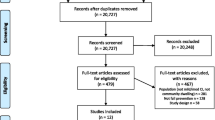Abstract
The authors hypothesized that cognitive impairment is associated with falls in older adults, but that transfer bias may obscure this association in cross-sectional community studies. The bias would arise if demented patients who fall are relatively unavailable to community surveys due to death or institutionalization. To test this hypothesis, a “dose-response” relationship between falls and cognitive impairment was tested for using data from a longitudinal cohort study of 157 patients with Alzheimer-type dementia. In a cross-sectional analysis of baseline data, when 96% of the cohort were community residents, the association between falls and cognitive impairment was insignificant (odds ratio for a 10-point change in Mini-mental State score =1.2, 95% confidence interval 0.76–1.9). Yet cognitive impairment at baseline predicted falls during three-year follow-up (OR=1.8, 95% CI 1.1–3.0). Both severity of dementia and falls were risk factors for death or institutionalization. Patients at highest risk for leaving the community during follow-up were those who became non-ambulatory. The authors conclude, based on longitudinal data, that there is a dose-response effect between cognitive impairment and falls. Transfer bias probably obscured the association at baseline. These data emphasize the importance of prospective studies of falls.
Similar content being viewed by others
References
Perry BC. Falls among the elderly: a review of the methods and conclusions of epidemiologic studies. J Am Geriatr Soc 1982; 30:367–71
Melton LJ, Riggs BL. Epidemiology of age-related fractures. In: Avioli LV, ed. The osteoporotic syndrome. New York: Grune and Stratton. 1983; 45–72
Kane RL, Ouslander JG, Abrass IB. Essentials of clinical geriatrics. New York: McGraw Hill Book Company, 1984;137–52
Rubenstein LZ. Falls in the elderly: a clinical approach. West J Med 1983;138:273–5
Isaacs B. Are falls a manifestation of brain failure? Age Ageing 1978(suppl);7:97–111
Mossey JM. Social and psychologic factors related to falls among the elderly. Clin Geriatr Med 1985;1:541–53
Buchner DM, Larson EB. Falls and fractures in patients with Alzheimer-type dementia. JAMA 1987;257:1492–5
Davie JW, Blumenthal MD, Robinson-Hawkins S. A model of risk of falling for psychogeriatric patients. Arch Gen Psychiat 1981;38:463–7
Prudham D, Evans JG. Factors associated with falls in the elderly: a community survey. Age Ageing 1981;10:141–6
Cook PJ, Exton-Smith AN, Brocklehurst JC, Lempert-Barber SM. Fractured femurs, falls and bone disorders. J R Coll Physicians Lond 1982;16:45–9
Campbell AJ, Reinken J, Allan BC, Martinez GS. Falls in old age: a study of frequency and related clinical factors. Age Ageing 1981;10:264–70
Feinstein AR. Clinical epidemiology. Philadelphia, W. B. Saunders, 1985;46–50:326–30
Anthony JC, LeResche L, Niaz U, et al. Limits of the “Mini-Mental State’ as a screening test for dementia and delirium among hospital patients. Psychol Med 1982;12:397–408
Nelson A, Fogel BS, Faust D. Bedside cognitive screening instruments. J Nerv Ment Dis 1986;174:73–83
Berkson J. Limitations of the application of fourfold table analysis to hospital data. Biometrics Bull 1946;2:47–53
Larson EB, Reifler BV, Sumi SM, Canfied CG, Chinn NM. Diagnostic evaluation of 200 elderly outpatients with suspected dementia. J Gerontol 1985;40:536–43
Reifler BV, Eisdorfer CA. A clinic for the impaired elderly and their families. Am J Psychiatr 1980;137:1399–1403
Eisdorfer C, Cohen D. Diagnostic criteria for primary neuronal degeneration of Alzheimer’s type. J Fam Pract 1980;4:553–7
Folstein MF, Folstein SE, McHugh PR. “Mini-Mental State”: a practical method for grading the cognitive state of patients for the clinician. J Psychiatr Res 1975;12:189–98
Dixon WJ, Brown MD, Engelman L, et al. BMDP Statistical Software, 1983 printing with additions. Berkeley, CA: University of California Press, 1983
Rothman KJ. Modern epidemiology. Boston: Little, Brown, 1986;23–34, 89
Wild D, Nayak USL, Isaacs B. Characteristics of old people who fell at home. Clin Exp Gerontol 1980;2:271–87
Author information
Authors and Affiliations
Additional information
Received from the Departments of Health Services and Medicine, University of Washington, Seattle, Washington, and the Northwest Health Services Research and Development Field Program, Seattle VAMC, Seattle, Washington.
Supported in part by grants AG05136, AG06456, P50MH40014, and 5-R01-MH33041. Dr. Larson was a Henry J. Kaiser Family Foundation Faculty Scholar in General Internal Medicine.
The views expressed are those of the authors.
Rights and permissions
About this article
Cite this article
Buchner, D.M., Larson, E.B. Transfer bias and the association of cognitive impairment with falls. J Gen Intern Med 3, 254–259 (1988). https://doi.org/10.1007/BF02596341
Issue Date:
DOI: https://doi.org/10.1007/BF02596341




